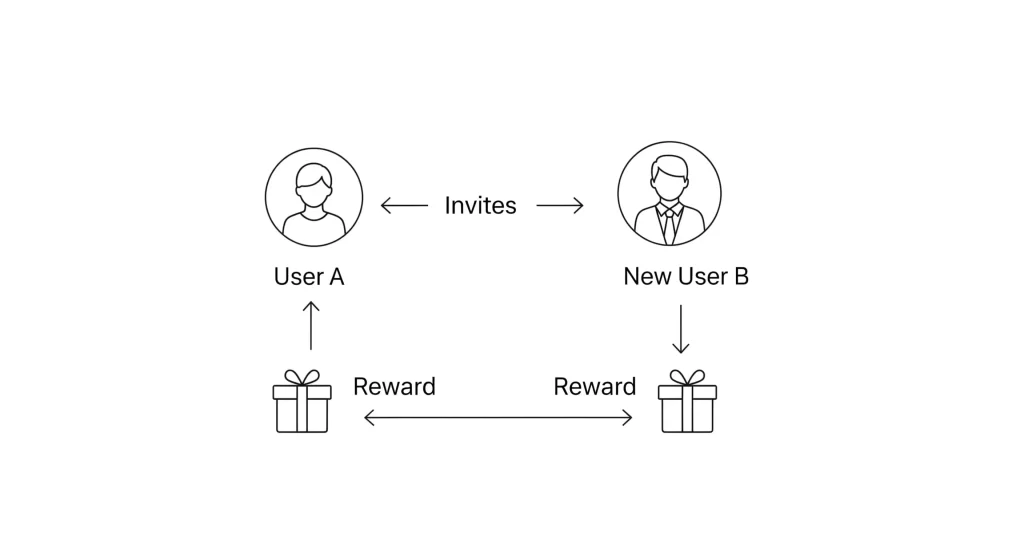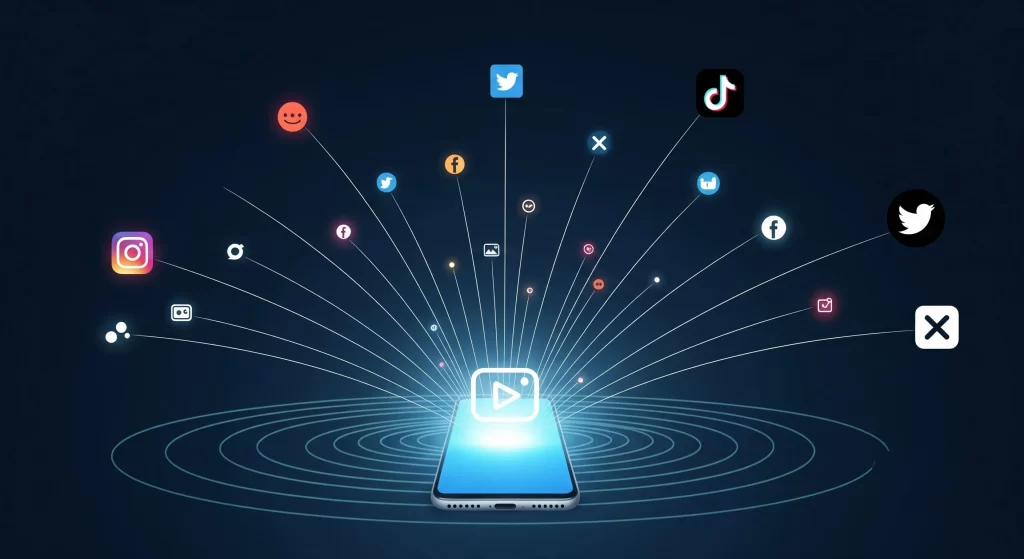Referral programs are good, but the most defensible apps have a secret: their users want to share, even without a reward. While incentivized referrals are a powerful tool, the next level of product-led growth comes from building systems where sharing is a natural, organic byproduct of using your app. This is the world of organic virality, powered by social viral loops and content loops.
This guide will explore the psychology behind why users share for free and provide a framework for engineering these sophisticated loops. You’ll learn how to move beyond simple transactions and build a product that users are intrinsically motivated to share, creating sustainable, high-quality growth.
Table of Contents
What are Social Viral Loops?
A social viral loop is a system where a user shares an achievement, status, or piece of content from your app to gain social capital, express their identity, or connect with a community. The act of sharing is not motivated by a financial reward, but by an intrinsic desire to communicate something about themselves to others.
These loops are incredibly powerful because they feel authentic to both the sender and the recipient. The shared content acts as a trusted, third-party endorsement of your app.
Key Examples:
- Strava: When a user shares a map of their 10k run, they are signaling their dedication and athleticism to their friends.
- Wordle: Sharing the daily grid of green and yellow squares signals intelligence and participation in a global trend.
- Gaming Apps: Sharing a “new high score” or a “rare item unlocked” is a classic example of status-driven social sharing.
You can see more examples in our detailed breakdown of 10 Viral Loop Examples from Top Apps.
The Power of User-Generated Content (UGC) Loops
Content loops take this a step further. In a UGC loop, the app’s core function is to enable the creation of content that is inherently shareable. The content itself becomes the primary marketing vehicle for the app.
This is the ultimate form of user generated content marketing because your users are, in effect, creating your advertisements for you. Every piece of shared content is a viral vector that can bring new users into your ecosystem.
Key Examples:
- TikTok: The entire platform is a UGC loop. Users create videos, and the app makes it frictionless to share them externally, complete with a watermark that drives attribution back to TikTok.
- Canva: Users create social media graphics, presentations, or invitations and share them. The professional quality of the output serves as a powerful advertisement for the Canva platform.
- Meme Generator Apps: The sole purpose is to create funny, shareable images. The app’s success is directly tied to how easily its content can be spread.
The Psychology: Why Do Users Share for Free?
To engineer successful social viral loops, you must understand the intrinsic motivations that drive a user to share without a financial reward. These motivations generally fall into four categories:
- Social Status & Pride: This is the “look what I did” impulse. Users share to demonstrate their skill, dedication, intelligence, or accomplishments. This is the primary driver behind sharing a high score, a workout summary, or a Duolingo streak.
- Self-Expression & Creativity: This is the “look what I made” impulse. Users share to express their personality, humor, or artistic talent. This powers every UGC loop, from TikTok videos to Canva designs.
- Community & Belonging: This is the “I’m part of this” impulse. Sharing signals membership in a group or participation in a shared cultural moment. The daily Wordle grid is a perfect example of this.
- Helpfulness: This is the “this could be useful to you” impulse. A user shares a link to a recipe from a cooking app or a product from an e-commerce app not for a reward, but because they genuinely believe it will benefit the recipient.
Your product’s sharing prompt should be designed to tap into one or more of these core motivations at the exact moment the user is feeling it most strongly.

The Technical Challenge: Making Sharing Seamless & Measurable
While these loops feel organic to the user, they require careful engineering to succeed. The two primary technical challenges are making the sharing experience frictionless and making the results measurable.
1. Engineering a Seamless User Experience
For a user to share content, the process must be incredibly easy. This means:
- Using Native Share Sheets: Don’t build a custom sharing interface. Use the built-in OS share sheet (`UIActivityViewController` on iOS, `ACTION_SEND` Intent on Android) that users are already familiar with.
- Pre-populating Messages: Reduce the user’s cognitive load by pre-filling the share text with compelling copy and a link.
- Creating Shareable Assets: Don’t just share a link. Generate a visually appealing image of the content or achievement that will look great on social media feeds.
2. Engineering a Measurable Loop
This is the most critical and often overlooked step. Even though you aren’t paying a commission, you absolutely must track the performance of your loops. Without data, you cannot optimize. You need to answer questions like:
- Do shared workout maps drive more installs than shared personal records?
- Which user-generated video templates are most likely to go viral?
This is where Tapp’s deep linking infrastructure becomes essential for two key reasons:
- Seamless User Experience for the Recipient: When a new user clicks a link to a specific piece of shared content, Tapp ensures they are taken directly to that content in the app after they install, not just dumped on the home screen. This smooth onboarding is critical for conversion.
- Measurable Virality: Tapp’s deferred deep linking allows you to attribute every new install back to the original piece of shared content or the user who shared it. This gives you the precise app virality analytics needed to understand what’s working and double down on your most effective loops.

Frequently Asked Questions (FAQ)
What is the main difference between a social loop and an incentivized referral program?
The key difference is the user’s motivation. An incentivized referral program is driven by an extrinsic reward (money, credits, features). A social viral loop is driven by an intrinsic reward (social status, pride, self-expression).
Can my app have more than one type of viral loop?
Absolutely. Many of the most successful apps have multiple loops. For example, a fitness app could have a social loop for sharing workout achievements and a separate, incentivized referral program that offers a free month of premium for successful invites.
How do I find the right “trigger point” to encourage a share?
Map out your user journey and identify the “moment of delight.” This is the point where the user has just received the maximum value from a feature. For a creative app, it’s right after they save their creation. For a game, it’s on the “level complete” screen. Prompting the share at this moment of peak emotional satisfaction will dramatically increase your share rate.
Is it still a “social viral loop” if the K-factor is less than 1?
Yes. Any system where existing users bring in new users is a loop. While a K-factor greater than 1 is the goal for exponential growth, even a loop with a K-factor of 0.1 is valuable, as it means you get one new user for free for every ten you acquire through other channels, lowering your overall customer acquisition cost.
Conclusion
Achieving true, sustainable app virality means graduating from simple incentives to building product features that users are intrinsically motivated to share. These organic social viral loops and content loops are the foundation of the most defensible growth engines in the mobile ecosystem.
While these loops feel natural to the user, they are the result of careful, deliberate engineering. Their success depends on a frictionless sharing experience and, crucially, a powerful tracking infrastructure like Tapp to make them measurable and optimizable. Without the ability to attribute new users back to the specific content that brought them in, you are simply guessing.
Ready to build a growth loop powered by your users’ passion? Sign up for your free Tapp account and start tracking your organic shares.
To understand the full technical framework for good social viral loops and virality, read our Engineer’s Guide to Creating Viral Loops for App Growth.
